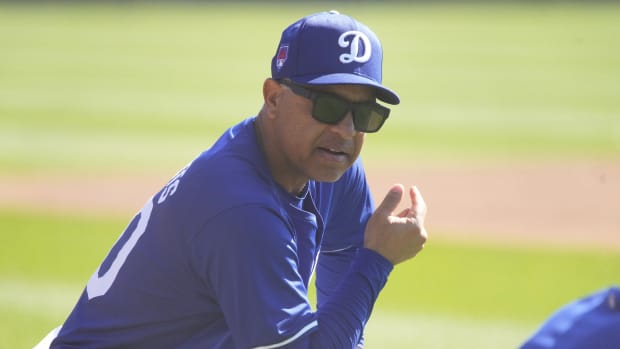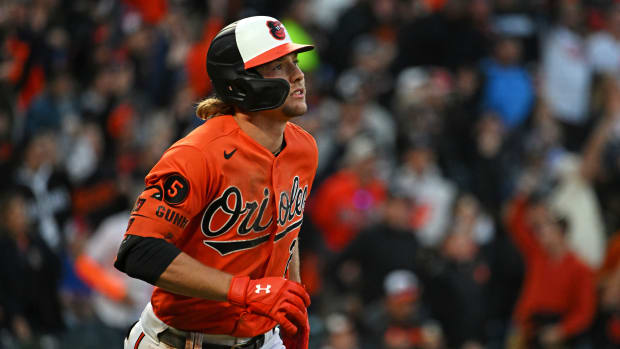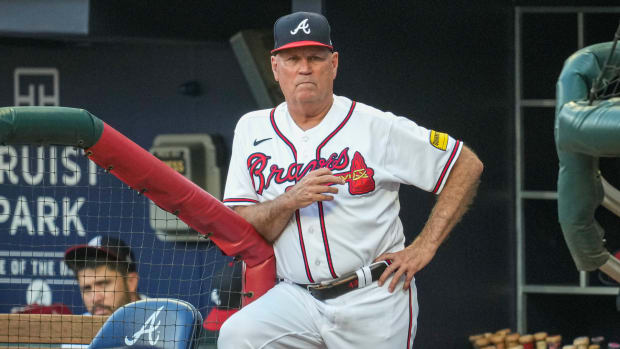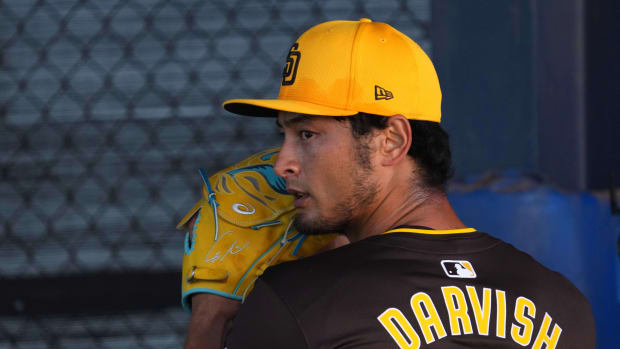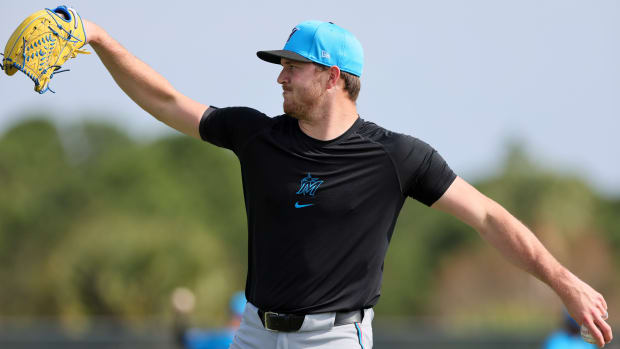Every Team's Most Memorable Closer

Baseball has no role designed for so much individualized significance as the closer. There’s the job description itself—either the shepherd of victory or the architect of defeat, with no space in between. There’s the setting, the lone man on the mound in the biggest moments of the game, his arrival signaled by signature music. There’s the style, in terms of both baseball (high heat) and aesthetics (those beards). Simply put, the closer is built to be remembered, for good or for bad. So for the next installment of SI’s Save Week, we’re running down each team’s most memorable closer—the wild, the elite, and the ones fans might rather forget.
AL East
Baltimore Orioles: Jim Johnson’s peak may have burned the brightest—he’s one of just three closers in history with multiple 50-save seasons, joining Mariano Rivera and Eric Gagne—but Zack Britton’s was steadier and puts him higher on the franchise’s career leaderboard for saves (139 of them, with three of the club’s top seven individual save seasons). Despite the fact that Britton’s most memorable appearance just might be the one he never made.
Boston Red Sox: There’s an easy statistical case to be made for Jonathan Papelbon—219 career saves for the franchise, far more than anyone else, including five seasons with at least 35—but even without considering any numbers, he’d get the nod for the balance of his trademark bravado with the filthy stuff to back it up. He can also dance.
New York Yankees: “God touched Mariano Rivera one June afternoon in 1997, and Rivera shrugged.” It’s hard to get more memorable than the record holder (652!), the first player unanimously elected to the Hall of Fame, the Sandman.
Tampa Bay Rays: Fernando Rodney may have spent only two seasons in Tampa Bay, but that was all it took to put him third on the franchise’s all-time leaderboard for saves. His 2012 still stands out as one of the best performances by a closer in the past decade—48 saves, 0.60 ERA, five strikeouts for every walk—and, besides, his arrow-slinging victory celebration alone is more impressive than any gaudy stat could be.
Toronto Blue Jays: Duane Ward’s 1993 season is arguably the best in franchise history by a closer, with 45 saves, 12.2 K/9, and a 2.13 ERA. And while he can’t lay claim to the title of hero for the team’s victory in the ’93 World Series (Joe Carter’s walk-off homer kinda takes precedence there), Read still played a crucial role here, if a less flashy one: He pitched the one-two-three ninth that made the iconic homer possible.
AL Central
Chicago White Sox: When Bobby Thigpen set a record with 57 saves in 1990, Jerome Holtzman—the newspaper writer who’d played a large role in creating the stat itself, decades earlier—wrote that he suspected the mark might stand forever. It didn’t, but it did stand for almost twenty years, and helped eventually earn the title of franchise saves leader for Thigpen, and that’s good enough for us.
Cleveland Indians: Cody Allen is the team’s career leader in saves, and Joe Borowski stands out with his league-leading 45 saves from 2007… but neither can approach the noteworthiness of José Mesa, man responsible for one of the most devastating blown saves in postseason history. Of course, this low point came alongside an otherwise respectable franchise career, 104 saves over seven years in uniform for Cleveland—including two appearances in the All-Star Game and one year as runner-up for Cy Young!—but even if he hadn’t had racked up any of these feats, Game 7 of the 1997 World Series would unfortunately still be enough to earn him this spot.
Detroit Tigers: Todd Jones’ first stint in Detroit, from 1997 to 2001, was memorable enough: 142 saves, which put him within a stone’s throw of the franchise record. And then he returned, at the age of 38 in 2006, and did something he’d never done in his younger years—35 saves or more for back-to-back seasons.
Kansas City Royals: Dan Quisenberry led the American League in saves five times from 1980 to 1985, a two-time runner-up for the Cy Young. Perhaps just as important, he was eminently quotable, published his own book of poetry, and had a perfect mustache.
Minnesota Twins: During each of his first six seasons in Minnesota, Joe Nathan recorded no fewer than 36 saves, with an ERA no higher than 2.70. There are a lot of impressive highlights, and a lot of impressive numbers, a particularly impressive one of which is this: Since 1975, there have been just four relievers to record a career Win Probability Added above 30, which is to say that there have been four relievers who statistically did more than any other to increase their teams’ chances of winning. The first three are exactly the names you’d expect (Rivera, Hoffman, Gossage). The fourth is Nathan.
AL West
Houston Astros: Technically, you could make a case for giving this to Charlie Morton, as it’s hard to get more memorable than the guy who closes out Game 7 to win the franchise’s first and only World Series… but we’ll play by the rules and pick someone who was actually a full-time close (and an excellent one, at that) in Billy Wagner.
Los Angeles Angels: Francisco Rodriguez’s 62 saves have stood as the all-time single-season record for more than a decade now—and, given relief pitching trends, it just might stand forever.
Oakland Athletics: It’s a tough battle here between Dennis Eckersley and Rollie Fingers. Each is among the most iconic closers ever. Both spent nine seasons in Oakland (though, for the purposes of this exercise, it’s worth making the distinction that Eck was closer for all nine of his, while Fingers only converted to the ‘pen after his first few years in town). Eckersley has the statistical edge (320 saves, 2.74 ERA vs. 136 saves, 2.91 ERA), but Fingers has the cultural one, after helping to establish the modern role of the closer. (Plus, his mustache has to be the equivalent of… 50 saves? 100, maybe?) Eckersley won a Cy Young and MVP in Oakland; Fingers’ editions of those awards didn’t come until he’d left town, though he did win a World Series MVP, as the man on the mound to close out two separate championships. The verdict? Make your pick. You can’t go wrong.
Seattle Mariners: Kazuhiro Sasaki’s MLB career was relatively short, at just four years, all of them in Seattle; he came over from Japan at the age of 32 in 2000. But four seasons was all the time needed to win Rookie of the Year, qualify for two All-Star Games, earn a few votes for MVP, and successfully close out 45 of the Mariners’ record-setting 116 wins in 2001.
Texas Rangers: Neftalí Feliz’s 2010 rookie season was his peak, with 40 saves and a 2.73 ERA (plus three scoreless innings in two appearances in the World Series), ultimately acknowledged by Rookie of the Year. Noteworthy enough… and yet (sorry, Rangers fans) still not exactly comparable to the kind of noteworthiness that accompanies blowing the save after coming within one strike of closing out the World Series in 2011.
NL East
Atlanta Braves: John Smoltz’s time as a closer was relatively short, just four years sandwiched into a lengthy and otherwise stellar career as a starter. But he packed as much into those four seasons as he could. He had three years with 44 or more saves (including a league-leading 55 in 2002). Some context there? There are only seven relievers in baseball history with so many seasons on such a high save total. For the other six, though, getting there meant building an entire career on closing—not just transitioning for a few years, getting to the top of the leaderboard, and switching back to the rotation.
Miami Marlins: Antonio Alfonseca began his career with five seasons in Miami, including being a key contributor in the 1997 World Series and becoming baseball’s saves leader in 2000, which is a fine base for being memorable, but nowhere compared to the memorability of having six fingers on each hand.
New York Mets: Armando Benítez’s five seasons with the Mets were long enough to build a very respectable record in the regular season (second in franchise save total, with 160), and to create lasting trust issues for an entire generation of fans in the postseason.
Philadelphia Phillies: Jim Konstanty wasn’t a closer in the traditional sense, because he was around before there was any tradition of closers. (He retired more than a decade before the save became an official statistic.) Still, in 1950, he became the first reliever to win MVP, and, while no one knew it at the time, the first pitcher ever to record more than 20 saves in one season in the NL. Beyond that, even though he hadn’t started a single game in the regular season, he was tagged to start Game 1 of the World Series—then, one of the most shocking pitching moves conceivable, and now, the beginning of a long history of creative ‘pen management in October.
Washington Nationals: The Nationals’ inaugural season of 2005 did not have very much to be excited about—a team that exactly met expectations by finishing in last place. But they did have Chad Cordero, who improbably led baseball with 47 saves and finished fifth in voting for the Cy Young. He’d never been anywhere near this good before, and he never was again. But for one year, the team’s first, he was among baseball’s best.
NL Central
Chicago Cubs: When Lee Smith retired, he was baseball’s all-time leader in saves, most of them from his time with the Cubs—all the more impressive when you consider that he wasn’t exactly overwhelmed with opportunities, given that the team only had one winning season in his eight years there.
Cincinnati Reds: Aroldis Chapman’s six seasons in Cincinnati brought 146 saves, 4 appearances in the All-Star Game, and a lot of triple-digit heat.
Milwaukee Brewers: Dan Plesac isn’t just Milwaukee’s all-time saves leader (133). He’s also the franchise leader in ERA (3.21), ERA+ (128), and FIP (3.30).
Pittsburgh Pirates: Roy Face received MVP votes as the team’s closer in each season from 1958 through 1960, garnering particular attention with an 18-1 record in 1959, despite not making a single start… which helped lead to the creation of the save, a statistic designed partially to prove that Face’s ’59 season wasn’t quite as effective as it had looked. Still, in a sense, Face got the last laugh here—the save wasn’t designated as an official stat until he had retired, but applied retroactively, he’s the franchise’s leader here.
St. Louis Cardinals: When Bruce Sutter was elected to the Hall of Fame in 2006, he became the first player to make it to Cooperstown without starting so much as a single game. In four years in St. Louis, he led baseball in saves twice, enjoyed two top-10 finishes for MVP, and closed out a World Series Game 7.
NL West
Arizona Diamondbacks: The Diamondbacks do not have something that have every other club in baseball has, which is at least one closer with 100 saves or more for the team in franchise history. The Diamondbacks do have Byung-Hyun Kim, in the tiny club of pitchers to record a save before their 21st birthday. (Just 20 have done it since 1970.) Yankees fans also remember him.
Colorado Rockies: Brian Fuentes is one of just seven lefty relievers with at least 200 career saves, and most of those came in Colorado, where he became the first reliever ever to represent the franchise in the All-Star Game and still reigns as its leader in saves.
Los Angeles Dodgers: Eric Gagne had just three full seasons as the Dodgers’ closer. That was all he needed to become the first pitcher ever to record 50-plus saves in back-to-back seasons, set a record for strikeout rate, and win a Cy Young. (Also, weirdly, Gagne pitched exactly 82.1 innings in each of those three seasons, which just might be the best trivia tidbit in a career that has several of them.)
San Diego Padres: Trevor Hoffman may not have been baseball’s all-time saves leader for very long—he grabbed the record by passing Lee Smith in 2006, only to be passed by Mariano Rivera in 2011, one year after his retirement—but he’ll be the first to reach five hundred saves forever. And the most inextricably linked to “Hells Bells.”
San Francisco Giants: Brian Wilson could have this space for his beard alone. Three All-Star appearances and being on the mound to close out the franchise’s first championship in half a century doesn't hurt. Hat tip here to Rod Beck as well.































